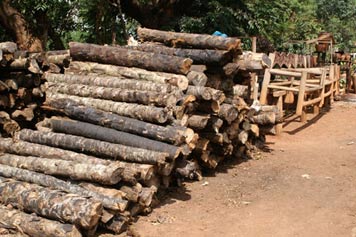
October 19, 2006
Charles Eames Among the Bullrushes

Uganda, bikeload of lumber, photograph by David Stairs, 2006
Occupying a strategic position at the headwaters of the Nile, Uganda is a landlocked country at the crossroads of East Africa. Yet its great inland sea, named Lake Victoria by the Bazungu but generally known as Nyanza to local tribes, has been an unceasing magnet to outsiders. It drew Arab traders from the 1830s on searching for slaves; Richard Burton and John Hanning Speke journeyed west of the Rift Valley, in 1856, in search of Royal Geographic Society fame and fortune; and, long before, it absorbed the great Bantu diaspora that swept through the region approximately two thousand years ago. Precisely because of its “landlocked” origins, some outside critics cling to the erroneous notion that Ugandans have no innate sense of design or creative originality, believing, instead, that things are imported to Uganda where they are eventually adopted.
Which is all a way of saying Ugandans are great sponges: they know how to absorb a good idea when they see it. Firearms, motorcars and cellphones are all examples of inventions developed elsewhere that have found a secure home in Uganda. But what about furniture? Is there a style or genre that is uniquely Ugandan or is that imported, too?

Palm log couches, photograph by David Stairs, 2006
While on a recent visit to Ggaba Road in Kampala, I saw great variety in domestic furniture making. As with most things in Uganda, this is a craft-based cottage industry. There are acres of overstuffed armchairs knocked together in roadside sheds, foam-covered and upholstered in the “latest” fashionable fabrics, sitting out on the roadside, night and day, rain or shine, patiently awaiting anyone with a few thousand shillings (usually upper-class Ugandans or foreigners) ready to spend.

Acres of stuffed chairs, photograph by David Stairs, 2006
Acres is the operative term here: acres of beds, acres of bookcases, acres of desks, tables and chairs. Many of these items are fashioned from wide, rough-hewn tropical planks, transported on the back of heavy bicycles, then sawn, sanded and varnished by hand by an army of workers. Labor is both cheap and plentiful in Uganda, and many such arduous tasks remain lovingly performed by hand.
One of the materials indigenous to Uganda is rattan, which is bent, twisted and shaped into a wide variety of items resembling Nineteenth-Century Thonet chairs. Many of the shopkeepers and street vendors I pass along the roadside are sitting on an akatebe ak’ ekibbo, or “basket stool.” The three-legged akatebe looks like a vortex, its inverted cone of concentric spirals creating a natural depression for a pillow or posterior. Akatebes are simple, durable and, at less than a dollar for the adult size, surprisingly affordable. And they can be accompanied by a full set of matching spiral or rush-seat chairs, shelves and beds.

Barak and an akatebe, photograph by David Stairs, 2006
Sometimes, you can find an anomalous gem salted away among these acres of redundancy. On one occasion, I came upon a man who was just finishing a suite of side chairs unique to Uganda. The frames were forged from welded steel, the seats and backs made of plywood. They reminded me of the many hours of my childhood spent in an American Seating bent-ply desk at St. Margaret’s Elementary in Mattydale, New York. As a material for furnishing, plywood has had a long history in Europe and America dating to the beginning of the 20th century (and admirably documented in the recent monograph from Princeton Architectural Press), but I had never before seen anyone attempt its use in Uganda.
In exchange for a photo of his product, I shared Charles Eames‘ secret of an intermediary rubber “doughnut” placed between the plywood and metal frame. This man became instantly excited. He’ll probably use small, round pieces of recycled car-tire sidewall as gaskets for his next batch of chairs.

“Eames” style chairs, photograph by David Stairs, 2006
I don’t know what influenced my 21st-century Charles Eames in Uganda. It’s possible he was just working off a chair he had seen in a local school or office. What interests me is the tendency for even uneducated Ugandans to observe and learn from their surrounding world, a fundamental hallmark of design thinking. Whether following traditional indigenous forms, like the akatebe, or reverse engineering overstuffed sofas and molded plywood sidechairs, Ugandan craftsmen work hard for small amounts of money in their pursuit of the vagaries of style, fashion and market share. It’s competitive out on that roadside. You need to keep your eyes wide open — and it helps to have a rush-plaited bassinet, just to stay afloat.
David Stairs is in Uganda for a year as a representative of Designers Without Borders. You can follow his exploits on his African Journal at Design-Altruism-Project.
Observed
View all
Observed
By David Stairs
Related Posts

Arts + Culture
Nila Rezaei|Essays
“Dear mother, I made us a seat”: a Mother’s Day tribute to the women of Iran

The Observatory
Ellen McGirt|Books
Parable of the Redesigner

Arts + Culture
Jessica Helfand|Essays
Véronique Vienne : A Remembrance

Design As
Lee Moreau|Audio
Announcing: Design As Season Two
Recent Posts
“Dear mother, I made us a seat”: a Mother’s Day tribute to the women of Iran A quieter place: Sound designer Eddie Gandelman on composing a future that allows us to hear ourselves think It’s Not Easy Bein’ Green: ‘Wicked’ spells for struggle and solidarity Making Space: Jon M. Chu on Designing Your Own PathRelated Posts

Arts + Culture
Nila Rezaei|Essays
“Dear mother, I made us a seat”: a Mother’s Day tribute to the women of Iran

The Observatory
Ellen McGirt|Books
Parable of the Redesigner

Arts + Culture
Jessica Helfand|Essays
Véronique Vienne : A Remembrance

Design As
Lee Moreau|Audio

 David Stairs founded Designers Without Borders in 2001 while on a Fulbright research grant to Uganda. In 2006, he became founding editor of
David Stairs founded Designers Without Borders in 2001 while on a Fulbright research grant to Uganda. In 2006, he became founding editor of